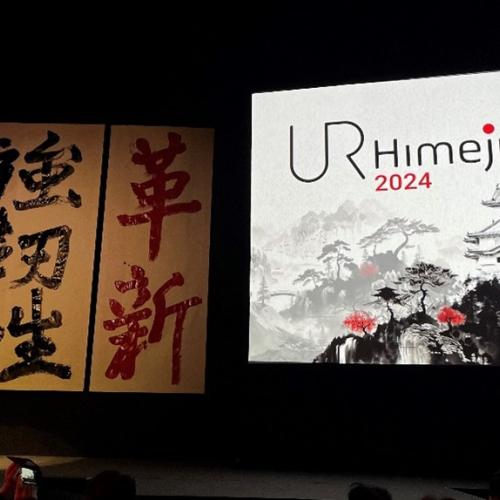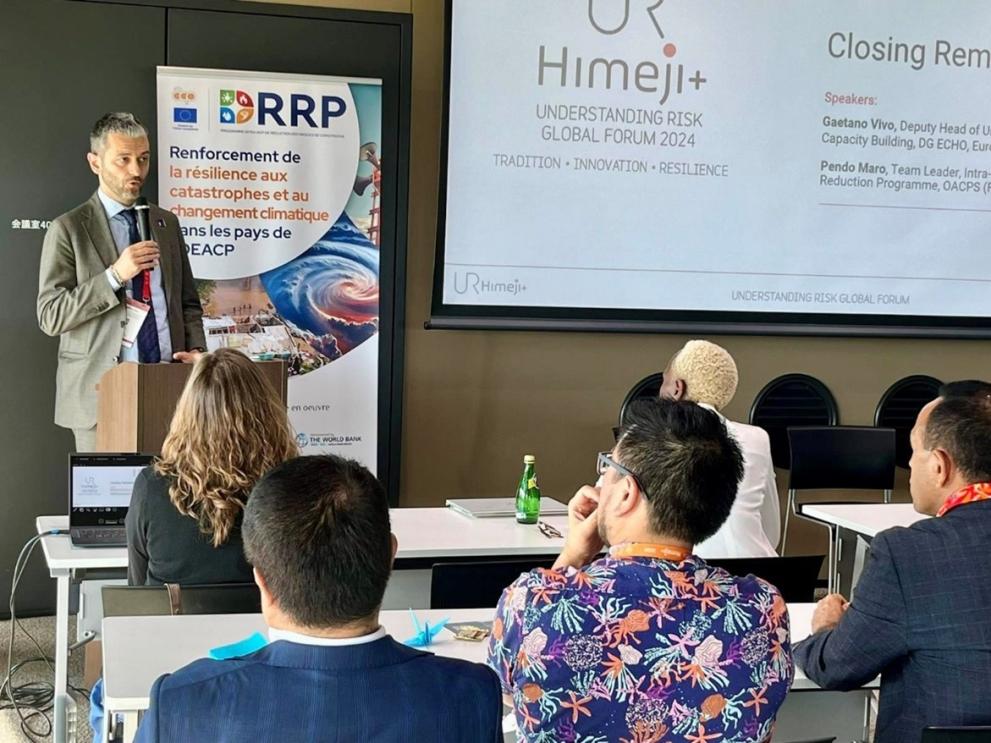
A View from the Understanding Risk Global Forum 2024
Averted Disaster Awards, building green shelters and disaster preparedness training for young people: Takeaways from the Himeji Forum.

Gaetano Vivo is Deputy Head of B3, the unit in DG ECHO that is responsible for the Knowledge Network, as well as capacity building for disaster prevention and preparedness. Gaetano recently attended the Understanding Risk Global Forum 2024 in Japan - the world’s largest forum on disaster prevention and preparedness, organised by the Global Facility for Disaster Reduction and Recovery (GFDRR). We spoke to Gaetano about his takeaways from the conference, and how this can be used within the UCPM.
Why was it important for you to attend the Understanding Risk Global Forum?
The 2024 Understanding Risk Forum, which took place in Himeji, Japan, brought together more than 1,700 participants from 137 countries and 700 organisations including government agencies, multilateral organisations, the private sector, NGOs, research Institutions, academia and civil society. Over six days it hosted more than 120 technical sessions, field visits, keynote speeches and other contributions. In addition to being a mega-event, Understanding Risk (or “UR”as it is often known) is also a large community of more than 20,000 experts, researchers and practitioners worldwide active in the creation, communication and use of disaster risk information for resilience.
For DG ECHO it was important to be there to share the latest progress of the EU’s work on disaster and climate resilience, on the policy, knowledge and capacity building fronts.

Other regions of the world are looking with a lot of interest at what the EU is doing in the area of disaster and climate resilience. Europe represents an example of advanced regional cooperation in managing and responding to disaster risks and can serve as “inspiration” for others, for instance Central Asia, Latin America, etc.
For me personally attending the UR Forum was a great opportunity to look at what others (e.g. in countries such as Japan, USA and Australia), are doing in areas which are most critical for Europe at the moment, for instance wildfires, awareness and preparedness of citizens, “smart” investments for prevention and climate adaptation.
What were the highlights for you?
So many that it is difficult to summarise them! I were to pick three:
Are there any takeaways that you can share for the UCPM?
I participated in a very interesting session on Nature-Based Solutions for managing the impact of climate change and disasters – it was interesting to hear how countries worldwide are implementing them and even to see some of these on display during the exhibition, where participants could touch some of the soil, grass, plants etc. which are used to absorb excessive heat and/or water, preventing disasters and, at the same time, capturing carbon emissions.
For the Commission promoting such solutions makes a lot of sense because they can help our Member States address the objectives of multiple EU policies, e.g. support nature restoration, biodiversity, flood risk management, climate adaptation, resilience goals, etc. Colleagues from the EU institutions will shortly be meeting to share knowledge and see what can be done to promote more investments in this area.

Building green shelters
The award-winning Japanese architect, Shigeru Ban, gave an eye-opening keynote address on building green, resilient and durable shelters built with sustainable materials (e.g. recycled cardboard tubes). Some of these buildings – including schools and hospitals - were produced in the aftermath of several disasters, crises and wars worldwide, including in Ukraine, Italy (following the L’Aquila Earthquake 2009), Haiti, Nepal, etc. The exhibition area of the UR Forum was built with the innovative cardboard system developed by Ms. Ban and the entire the structure was re-purposed for emergency housing after the event.
Averted Disaster Awards
I also participated in the ceremony of the Averted Disaster Award (ADA). This prize, which is awarded during the UR Forum, aims to spotlight the most effective prevention and preparedness projects worldwide using an evidence-based approach (counter-factual analysis).
The ‘Averted Disaster Awards’ sound interesting! Can you tell us more about them?
As we all know too well, prevention is often not in the limelight when talking about disasters and climate change. Often one of main reasons is that it is difficult to talk about it in a tangible, visual way. In most cases an averted disaster or a crisis which finds us prepared to respond with no fatalities and very little damage is no news. The challenge is to communicate what would have happened if those interventions, for prevention and preparedness, had not been there.

This award is a way to recognise successful disaster mitigation interventions around the world that often go unnoticed by the very nature of their success.
What can we learn from the UR Forum for the CP Forum? How do the two compare?
We can think of the UR Forum as the “world version” of our Civil Protection Forum: both in terms of the participants and the geographic scope of the issues discussed in the meeting. Granted, the Union Civil Protection Mechanism focus is on Europe but it is important that we regularly open up windows on other regions of the world which are grappling with similar issues as ours. By doing that we can learn from others while our experience will help others too.
The Union Civil Protection Knowledge Network is well placed to facilitate this link. For instance, starting this Autumn, we have planned a number of knowledge events on strategic topics for Europe, such as behavioural aspects of societal preparedness, Artificial Intelligence for disaster risk management, climate resilience, etc. where we plan to invite speakers and participants from outside the EU. It is a concrete way to open the UCPM to the rest of the world and promote innovation and a dialogue in both directions.

The Knowledge Network editorial team is here to share the news and stories of the Knowledge Network community. We'd love to hear your news, events and personal stories about your life in civil protection and disaster risk management. If you've got a story to share, please contact us.
Sectors
Risk drivers
Thematic series